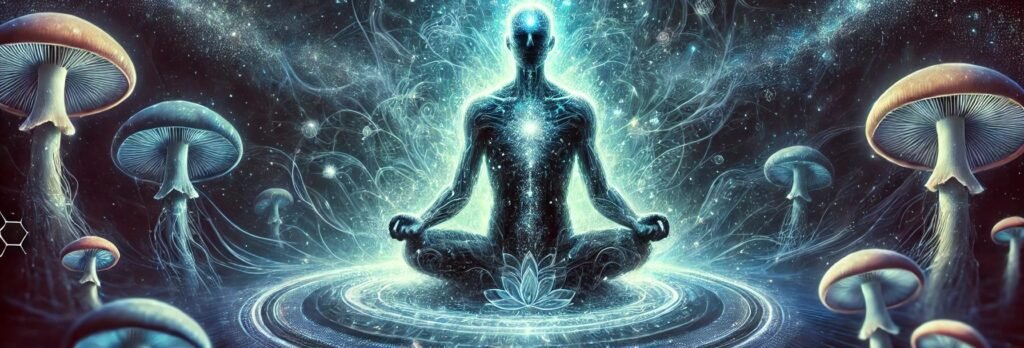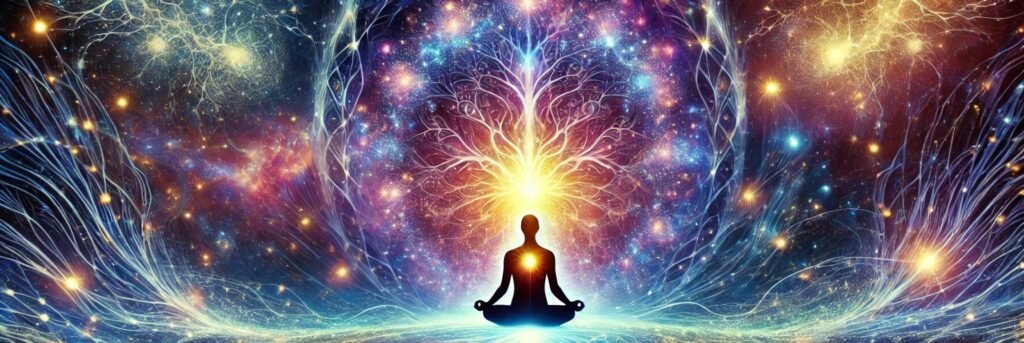Unveiling Ancient Truths Through Quantum Physics and Neuroscience
Perusing today’s news, we see that modern science continues to probe the same landscapes mystics have explored throughout time. As breakthroughs in neuroscience and quantum physics unfold, we are witnessing the unveiling of truths that mystics have described for millennia—truths about the nature of consciousness, the fluidity of time, and the interconnectedness of all things. From the effects of psilocybin on the brain to the latest revelations about the structure of space-time, science is beginning to uncover what ancient wisdom traditions have long known: that the fabric of reality is far more mysterious and profound than we have ever imagined.
Each of these discoveries reflects not only the insights of mysticism but also aligns deeply with the Diamond Approach®’s love of truth, its emphasis on curiosity, open-ended inquiry, and the enlightenment drive—the fundamental urge within human beings to know. It is in our very nature to seek, inquire, and understand the reality of who and what we are.

The Mystical Experience of Oneness
Research into psilocybin reveals that this substance dissolves the ego, opening individuals to a direct experience of interconnectedness. Mystics across traditions have long spoken of ego dissolution as the path to unity with all that is. Whether it’s the Sufi concept of fana (annihilation in the Divine) or Buddhism’s anatta (no-self), these experiences are encounters with the essential truth that all separateness is an illusion.
A recent article highlights that “psilocybin appears to reduce the activity of the brain’s default mode network (DMN), typically active when a person is engaged in self-referential thoughts.” This mirrors the experience of many mystics who describe a dissolving of the ego in their search for union with the Divine. From the Diamond Approach perspective, this is where the love of truth reveals itself.
Psilocybin’s ability to take us beyond the ego can be seen as an invitation to perceive reality without the distortions of personal identity. The inquiry into “Who am I when the self dissolves?” is open-ended, and the answer is always deeper than anticipated. This hunger drives mystics and modern psychonauts alike to know the truth beneath the surface appearances of separation.

Mystical Experience of Timelessness
Recent studies on the hippocampus and psilocybin’s effects on memory show that our perception of time is more flexible and fluid than we once thought. Mystics have always understood this, describing their experiences of timelessness, of dwelling in the eternal now.
In the Christian mystic tradition, Meister Eckhart spoke of transcendent moments where time ceased to exist, which aligns with modern findings about the malleability of our memory and time perception. Researchers have found that “the hippocampus is responsible for time-stamping memories. ” When this system is disrupted, time seems to become fluid, a condition psilocybin also induces.
This fluidity parallels mystical experiences where the linear nature of time collapses, giving way to an eternal present. For the Diamond Approach, such experiences speak to the essential curiosity of the soul. The more we explore, the more we begin to see that time itself is not what we think it is.
Curiosity drives us to ask: What is time? What is memory? What happens when the soul touches an eternal dimension? Through open-ended inquiry, we learn that time is less of a line and more of a living, dynamic presence with which our mind and consciousness interact.

Mystical, Fragile Reality
John Wheeler’s proposal that reality is participatory and shaped by observation closely mirrors mystical understandings of reality as dynamic and ever-changing. Mystics from the Buddhist tradition describe the world as maya, an illusion shaped by the mind’s interaction with it. Wheeler’s suggestion of a tear in the fabric of reality touches upon the same open-ended inquiry that drives the Diamond Approach—this fascination with knowing the nature of reality.
Wheeler argued, “We are no longer satisfied with a picture of reality that holds the stage independently of the observer.” This resonates with mystical perspectives that view reality as interactive, co-created through consciousness. For the Diamond Approach, reality is not static but always open to further discovery. We are not only participants in it but also seekers of what lies behind appearances.
“What is real?” leads us into deeper truths, often beyond what the mind can conceive. This unending search aligns with the mystical sense that reality is fragile, dynamic, and co-created by consciousness itself.

Mystical Interconnectedness and the Enlightenment Drive
The holographic universe theory, suggesting that each part of the universe reflects the whole, is a striking echo of mystical teachings. Hindu and Buddhist mystics have long spoken of this interconnectedness, often through metaphors like Indra’s Net, where each jewel reflects every other.
In Kabbalah, the universe is also seen as a holographic emanation from the Divine, with every part containing the whole. “Mathematicians discovered long-forgotten principles that could help decode the universe’s holographic nature,” a recent article reveals. This discovery suggests that what mystics have known for centuries may be proven mathematically that every part of the universe contains the whole.
The Diamond Approach frames this as the soul’s enlightenment drive, the innate desire to know the truth and to understand how everything is connected. This drive is part of what propels us toward unity with reality. Each experience we have, each part of ourselves we explore, reflects something more profound about the universe. The inquiry “How am I connected to everything else?” is not just philosophical—it is experiential, drawing us to realize that every fragment of existence holds its entire truth.

Non-Local Reality
Quantum geometry’s revelation that there are structures beyond space and time aligns with the mystical traditions that have long described realms outside ordinary space and time. Tibetan Buddhism’s bardo and Sufism’s alam al-mithal are two such examples.
This discovery affirms mystical experiences of higher realms, where space and time dissolve. For the Diamond Approach, this discovery speaks to the open-ended nature of inquiry. Mystics have often described non-local realms where consciousness travels beyond the constraints of the physical world.
The question “What is beyond space and time?” has always driven human beings to search for deeper understanding. The curiosity to go beyond the limits of our physical senses, to touch something transcendent, is an essential part of the soul’s journey toward truth. This drive to explore the non-local, the non-physical, is a part of our nature that seeks to comprehend the full scope of reality.

Portals to the Divine
The discovery of a 1-in-10 billion quantum event that challenges the foundations of what we understand about reality mirrors the mystical experiences of anomalies—moments where the fabric of ordinary reality unravels, allowing glimpses into the divine. Mystics like Rumi have described these moments as portals into higher truths.
The boundaries between known and unknown, seen and unseen, dissolve in these moments. The article describes this as “a rare and strange quantum event, which could challenge the foundations of modern physics.” This reflects mystical moments of transcendence, where the usual rules of reality no longer apply, and deeper truths are revealed.
For the Diamond Approach, these quantum anomalies reflect the soul’s fascination with the unknown – the dance between not-knowing and revelation. The question, “What happens when reality doesn’t behave as expected?” can lead to profound revelations. These moments of anomaly—both in science and spiritual experience—show us that there is always more to discover and that reality is far stranger and more wondrous than we can imagine.

Universal Mind
Whether the universe is conscious mirrors one of mysticism’s most profound teachings: that the universe and consciousness are not separate. From Advaita Vedanta’s assertion that the universe is an expression of Brahman, to Sufism’s Wahdat al-Wujud (the unity of existence), the idea that consciousness underlies all reality has been a cornerstone of mystical traditions.
A recent article ponders, “Is the universe itself conscious?” as physicists and neuroscientists explore the possibility that consciousness is a fundamental feature of the cosmos.
For the Diamond Approach, the love of truth and the soul’s enlightenment drive propels us toward this understanding. Human beings want to know. It is in our nature to seek the truth, to inquire into the nature of the universe and our consciousness. The inquiry “Is the universe conscious?” isn’t just a scientific or philosophical question; it reflects a deep human yearning to know the nature of existence itself.

Bridging Science and Mysticism
As modern science continues to explore the mysteries of reality, consciousness, and time, it touches on the same truths that mystics have sought throughout the ages. This convergence of science and mysticism speaks to something fundamental about the human experience—our drive to know. Whether through scientific discovery or mystical inquiry, we are propelled by a deep love of truth, an innate curiosity, and a relentless desire to understand reality as it truly is.
The Diamond Approach reminds us that this search is open-ended and that reality is always deeper than expected. As science uncovers more about the nature of the universe, it echoes the mystics’ wisdom: we are not separate from the universe; we are participants in its unfolding. Our journey toward understanding reality is intellectual and experiential, driven by the soul’s yearning for truth. As we discover, the answers we seek lie in the outer cosmos and within the depths of our consciousness.





